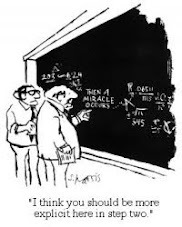OF ALL the economic bubbles that have been pricked, few have burst more spectacularly than the reputation of economics itself. A few years ago, the dismal science was being acclaimed as a way of explaining ever more forms of human behaviour, from drug-dealing to sumo-wrestling. Wall Street ransacked the best universities for game theorists and options modellers. And on the public stage, economists were seen as far more trustworthy than politicians. John McCain joked that Alan Greenspan, then chairman of the Federal Reserve, was so indispensable that if he died, the president should “prop him up and put a pair of dark glasses on him.”
In the wake of the biggest economic calamity in 80 years that reputation has taken a beating. In the public mind an arrogant profession has been humbled. Though economists are still at the centre of the policy debate—think of Ben Bernanke or Larry Summers in America or Mervyn King in Britain—their pronouncements are viewed with more scepticism than before. The profession itself is suffering from guilt and rancour. In a recent lecture, Paul Krugman, winner of the Nobel prize in economics in 2008, argued that much of the past 30 years of macroeconomics was “spectacularly useless at best, and positively harmful at worst.” Barry Eichengreen, a prominent American economic historian, says the crisis has “cast into doubt much of what we thought we knew about economics.”
In its crudest form—the idea that economics as a whole is discredited—the current backlash has gone far too far. If ignorance allowed investors and politicians to exaggerate the virtues of economics, it now blinds them to its benefits. Economics is less a slavish creed than a prism through which to understand the world. It is a broad canon, stretching from theories to explain how prices are determined to how economies grow. Much of that body of knowledge has no link to the financial crisis and remains as useful as ever.
And if economics as a broad discipline deserves a robust defence, so does the free-market paradigm. Too many people, especially in Europe, equate mistakes made by economists with a failure of economic liberalism. Their logic seems to be that if economists got things wrong, then politicians will do better. That is a false—and dangerous—conclusion.
Rational fools
These important caveats, however, should not obscure the fact that two central parts of the discipline—macroeconomics and financial economics—are now, rightly, being severely re-examined. There are three main critiques: that macro and financial economists helped cause the crisis, that they failed to spot it, and that they have no idea how to fix it.
The first charge is half right. Macroeconomists, especially within central banks, were too fixated on taming inflation and too cavalier about asset bubbles. Financial economists, meanwhile, formalised theories of theefficiency of markets, fuelling the notion that markets would regulate themselves and financial innovation was always beneficial. Wall Street’s most esoteric instruments were built on these ideas.
But economists were hardly naive believers in market efficiency. Financial academics have spent much of the past 30 years poking holes in the “efficient market hypothesis”. A recent ranking of academic economists was topped by Joseph Stiglitz and Andrei Shleifer, two prominent hole-pokers. A newly prominent field, behavioural economics, concentrates on the consequences of irrational actions.
So there were caveats aplenty. But as insights from academia arrived in the rough and tumble of Wall Street, such delicacies were put aside. And absurd assumptions were added. No economic theory suggests you should value mortgage derivatives on the basis that house prices would always rise. Finance professors are not to blame for this, but they might have shouted more loudly that their insights were being misused. Instead many cheered the party along (often from within banks). Put that together with the complacency of the macroeconomists and there were too few voices shouting stop.
Blindsided and divided
The charge that most economists failed to see the crisis coming also has merit. To be sure, some warned of trouble. The likes of Robert Shiller of Yale, Nouriel Roubini of New York University and the team at the Bank for International Settlements are now famous for their prescience. But most were blindsided. And even worrywarts who felt something was amiss had no idea of how bad the consequences would be.
That was partly to do with professional silos, which limited both the tools available and the imaginations of the practitioners. Few financial economists thought much about illiquidity or counterparty risk, for instance, because their standard models ignore it; and few worried about the effect on the overall economy of the markets for all asset classes seizing up simultaneously, since few believed that was possible.
Macroeconomists also had a blindspot: their standard models assumed that capital markets work perfectly. Their framework reflected an uneasy truce between the intellectual heirs of Keynes, who accept that economies can fall short of their potential, and purists who hold that supply must always equal demand. The models that epitomise this synthesis—the sort used in many central banks—incorporate imperfections in labour markets (“sticky” wages, for instance, which allow unemployment to rise), but make no room for such blemishes in finance. By assuming that capital markets worked perfectly, macroeconomists were largely able to ignore the economy’s financial plumbing. But models that ignored finance had little chance of spotting a calamity that stemmed from it.
What about trying to fix it? Here the financial crisis has blown apart the fragile consensus between purists and Keynesians that monetary policy was the best way to smooth the business cycle. In many countries short-term interest rates are near zero and in a banking crisis monetary policy works less well. With their compromise tool useless, both sides have retreated to their roots, ignoring the other camp’s ideas. Keynesians, such as Mr Krugman, have become uncritical supporters of fiscal stimulus. Purists are vocal opponents. To outsiders, the cacophony underlines the profession’s uselessness.
Add these criticisms together and there is a clear case for reinvention, especially in macroeconomics. Just as the Depression spawned Keynesianism, and the 1970s stagflation fuelled a backlash, creative destruction is already under way. Central banks are busy bolting crude analyses of financial markets onto their workhorse models. Financial economists are studying the way that incentives can skew market efficiency. And today’s dilemmas are prompting new research: which form of fiscal stimulus is most effective? How do you best loosen monetary policy when interest rates are at zero? And so on.
But a broader change in mindset is still needed. Economists need to reach out from their specialised silos: macroeconomists must understand finance, and finance professors need to think harder about the context within which markets work. And everybody needs to work harder on understanding asset bubbles and what happens when they burst. For in the end economists are social scientists, trying to understand the real world. And the financial crisis has changed that world.
From The Economist print edition, July 16th 2009























